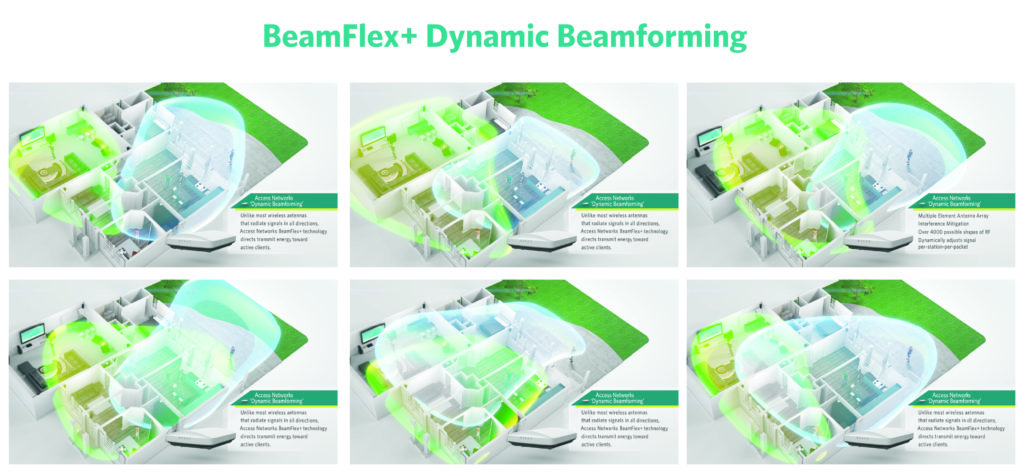The Access Blog
The Benefits of BeamFlex-Enabled Wireless Access Points to a Digital Lifestyle
Categorized: The Access Blog | June 15, 2021
How this innovative technology from Access Networks improves Wi-Fi connectivity for better range, reliability, and speed
Imagine yelling to a friend from across a noisy concert hall. It’s unlikely that he or she will be able to hear you. Now grab a megaphone and try again. You’ll have much better luck communicating when all of your verbal energy is focused in one direction versus a whole crowd. Add movement into the mix and it becomes even more difficult.
This analogy applies to the Wi-Fi reception in your home. With so many mobile devices constantly competing for bandwidth, it’s a tough environment for Wi-Fi signals to communicate with clarity. The end result: smartphones, tablets, computers, streaming media players, and other smart home products struggle to connect simultaneously, impacting their overall performance and your Wi-Fi experience.

Focused Wi-Fi Energy Leads to Better and Further Signal Reception
Wireless access points (APs) help matters by sending and receiving Wi-Fi signals throughout specified coverage zones, but it takes a special kind of AP to effectively overcome the inherent transmission hurdles that exist within households.
Unique BeamFlex technology, built into every Access Networks AP, works like thousands of tiny megaphones. BeamFlex aims Wi-Fi energy at each specific device, when and where it’s needed, rather than spreading the signal in all directions as a normal AP would. As a result, interference from other Wi-Fi devices decreases and signal strength increases for more reliable, stable, faster connectivity. Plus, Wi-Fi signals can travel further when they travel in a focused direction instead of a wide beam, which is the way common omnidirectional APs transmit Wi-Fi signals. Longer range enables a single BeamFlex AP to do the job of what could require several conventional APs.
Wi-Fi That Adapts to You and Your Devices

Few Wi-Fi devices sit in one spot for very long. Phones, tablets and laptops typically move with you, which means that with conventional APs, signals could strengthen or weaken depending on where you are in your home.
With BeamFlex technology, the AP will reconfigure its antenna pattern hundreds of times a second to achieve maximum focused coverage as you move throughout your home.
Better Two-Way Communication Between the AP and Wi-Fi Devices
APs not only direct Wi-Fi energy towards devices, but also pick up signals from those devices. Consistent two-way communication is a critical factor that influences Wi-Fi performance. If a AP fails to hear a command issued from a smartphone to a Wi-Fi-enabled door lock or light switch, for example, the entire home environment is impacted. Thanks to their polarized horizontal and vertical antenna orientation, BeamFlex APs listen better than ordinary APs. They are able to connect reliably and consistently with devices regardless of where the antennas of those devices are aimed.
With the latest update, BeamFlex+, a vertical antennae orientation was added to the usual horizontal alignment. They call it BeamFlex+ because it quite literally displays the horizontal and vertical axis. What does this mean? It means that smartphones, for example, sometimes sit horizontally on a table; other times, they’re held upright. BeamFlex+ uses the right antenna to create the clearest, strongest Wi-Fi signal path. The addition of the vertical orientation also allows for three-dimensional tracking from one floor to the next.
Wi-Fi that Works Smarter, Not Harder
Why blast your home with Wi-Fi and hope for the best when you can confidently connect and enjoy Wi-Fi from anywhere in a home with consistency, stability, reliability, and speed. Through smart antennas and patented software algorithms, BeamFlex technology takes Wi-Fi to the next level of performance with APs that intelligently choose the best signal path for Wi-Fi transmission and reception.
Download the BeamFlex+ cut sheet here. For more information on BeamFlex+ technology, please contact us here.